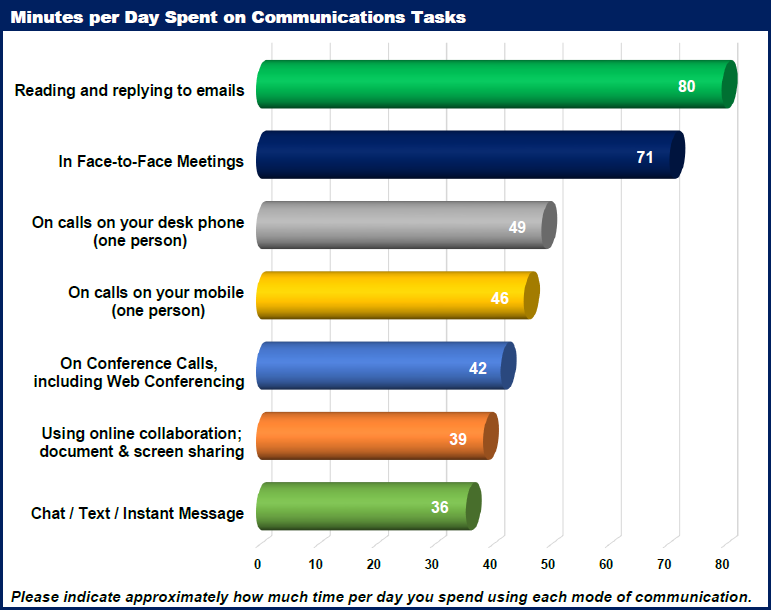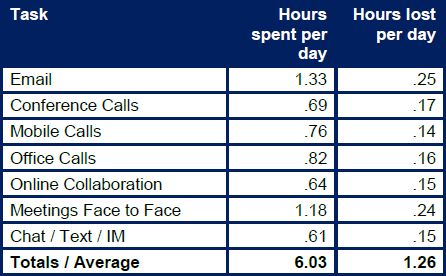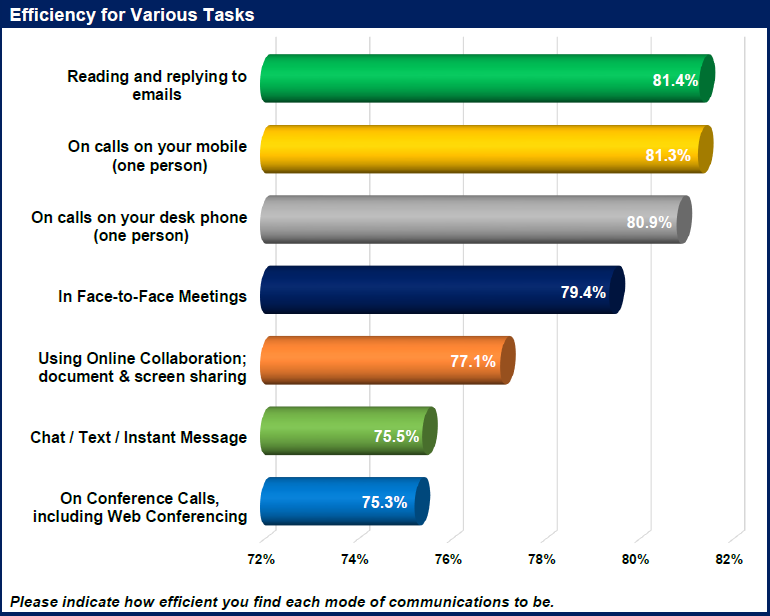A recent study by Ottawa-based enterprise communications firm Mitel Networks has concluded that inefficient methods of communication are costing businesses more than $15,000 USD per employee, per year.
To reach this number, researchers Steven Taylor and Leslie Barteaux from North Carolina-based Webtorials started by surveying 906 business professionals across four sample groups on Mitel’s behalf, including more than 250 each from the U.K., France, and Germany. (The majority of remaining respondents were from the U.S.)
Citing expertise from both MIT and the U.S. Bureau of Labour Statistics, Taylor and Barteaux then multiplied the respondents’ average salary of $75,888 (all numbers USD) by 1.4 to calculate the true cost of each employee to their company: $106,242.63 on average.
Separately, they calculated the average number of minutes employees spent on various communication tasks such as reading and replying to emails and instant messaging – and the number lost when choosing, for example, group email over conference calls (more on this below).
In all, the average respondent spent just over six hours per day engaging in some type of communication activity:

Courtesy Mitel

Hours lost by task. Courtesy Mitel.
“The respondents work 43.96 hours per week,” Taylor and Barteaux wrote in the Webtorials report based on the survey. “Assuming a five-day week, this is 8.8 hours per day. They spend 6.03 hours on communications and collaboration tasks, resulting in 68.6 per cent of their time. Based on the actual cost, this is $72.929.22 per year.”
“Of the communications 6.03 hours, they lose 1.26 hours due to inefficiencies, or 20.9 per cent,” they continued. “Based on the actual cost of this time, the time lost due to inefficiencies is $15,185.37 per employee [emphasis ours].”
The researchers also noted that the typical company for which the respondents worked employs an average of 3460 employees – meaning the typical company is losing $52,541,380.96 to inefficient communication methods.
Taylor and Barteaux’s conclusion, naturally enough, is that businesses should invest in more efficient communications infrastructure: “While there is no communication and collaboration infrastructure that can recover all this expense, a careful examination of methods and systems can have an immense payoff in recouping tens of millions of dollars,” they wrote.
So why are emails less efficient than instant messaging, anyway?
Once respondents had defined how much time they spent on various communication tasks, Taylor and Barteaux asked them to rate the efficiency of each task on a sliding scale:
- Totally efficient, no wasted time (100 per cent);
- Almost totally efficient, very little wasted time (90 per cent);
- Fairly efficient, but some wasted time (75 per cent);
- Not very efficient, lots of wasted time (50 per cent);
- Inefficient, lots of wasted time (25 per cent);
- Total waste of time (0 per cent).
When calculated, the average communication method was deemed 79 per cent efficient, with only six percentage points separating most and least.

Courtesy Mitel
As for why one type of communication might be seen as less efficient than another, the researchers believe a key reason might be employees using a less-than-optimal method for the task at hand.
“For instance, email often is used for a ‘chat’ with a barrage of short messages,” Taylor and Barteaux wrote. “And while email is great for documenting conversations and including a large number of participants in a conversation, the ability to copy a large group of people on a conversation cal also lead to inefficiency.”
And regardless of the platform, a tendency for employees to combine work-related and personal messaging leads to inefficiency as well, they noted.
You can download the full report here.



